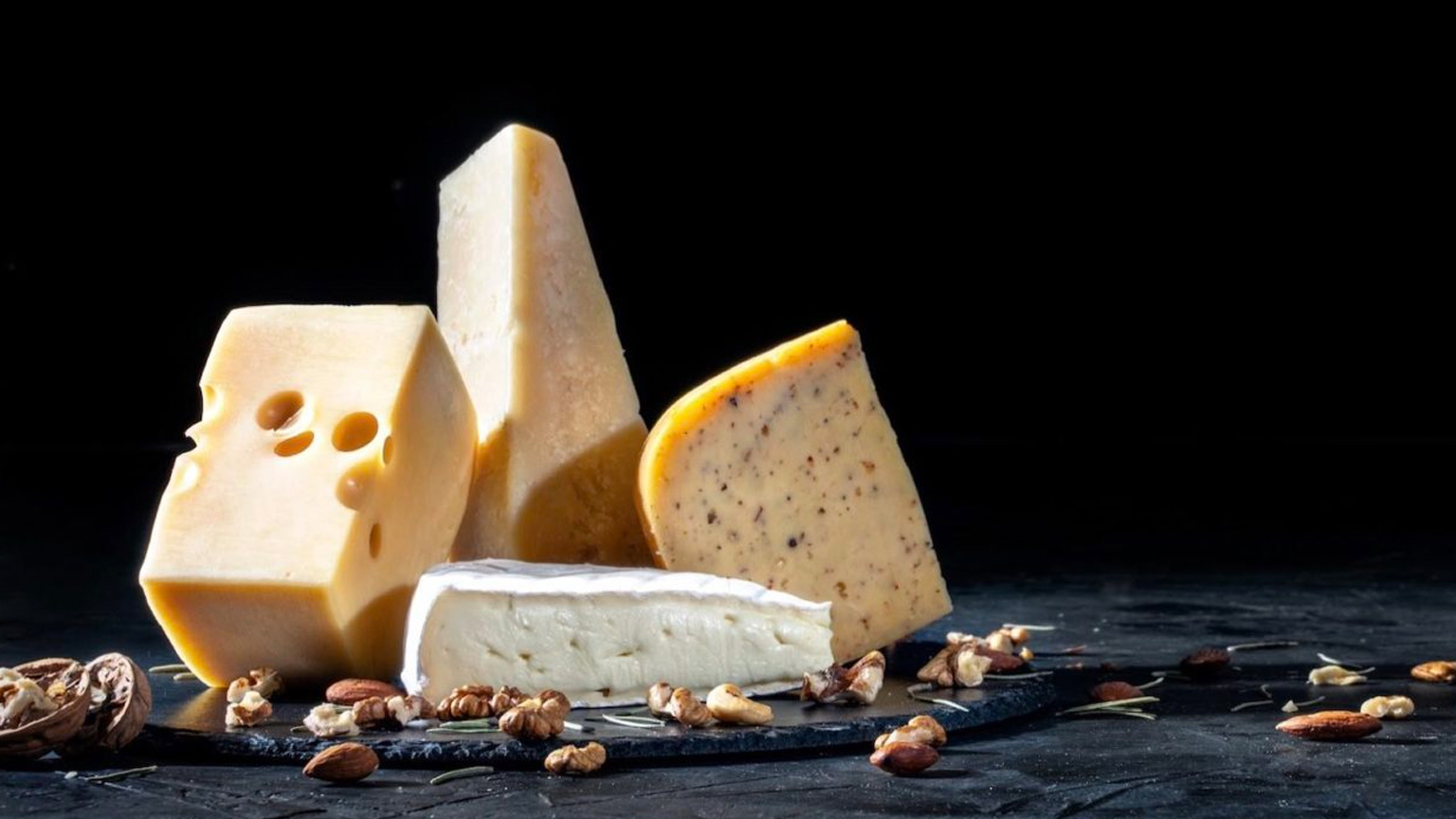By Brian D’Ambrosio
Local agricultural producers have to find new ways to stay in business in Montana. With the aid and support of consumers and customers, a number of small-scale operations, including several cheesemakers, are helping alleviate the crisis of disappearing farms.
In addition to creating the local food system many of us desire—one that regenerates the Earth, cares for animals, nourishes people and strengthens communities—these men, women and families are living lives that are perfect for them doing what they love.
While cheese might not be Montana’s most prodigious agricultural bounty—the state ranks highest in the production of lentils, honey and sugar beets—it might be its most nuanced, diverse and unformed component.
Through rigorous application and well-defined skill, and with a little bit of good fortune and love, these crafty souls might require us to someday add cheese to the long list of things that makes Montana independent and exceptional.
Flathead Lake Cheese Company
Housed in a vivid yellow creamery in Polson, the Flathead Lake Cheese Company supports local dairies with the production of its artisanal yields.
“There used to be a lot of them in the Mission Valley,” said owner Wendi Arnold of dairy farms. “I think there were as many as 70 at one point not long ago, but now there are only a couple left.”
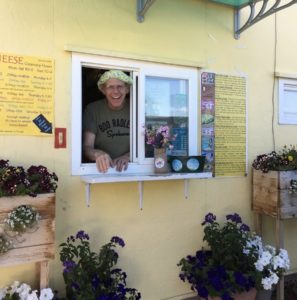

Joe Arnold of Flathead Cheese Company peers out of the cheese window. PHOTO COURTESY OF FLATHEAD CHEESE COMPANY
Bucking the downward slope of vanishing agriculture, Wendi and her husband Joe are at the start of their 11th season of commercial cheese production, and Wendi said that the two are still having a grand time strengthening the whole ecosystem of local food with a host of original, tasty goods.
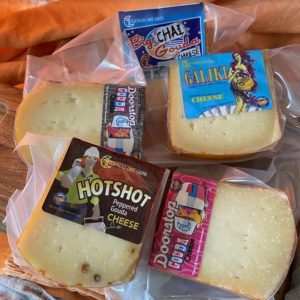

Flathead Cheese Company specializes in Gouda, like their
Hotshot (peppered) and Galiki (roasted garlic nibs). PHOTO COURTESY OF FLATHEAD CHEESE COMPANY
“Both my husband and I are entertainers and we are goofballs,” said Wendi. “And as long as we love what we do, we’ll keep doing it.”
Artisanal Cheese: An Interchange of Factors
Still inspired by the course and development of cheesemaking, Wendi said that the individual draw of a particular cheese is determined by the interplay between four important factors: location, recipe, ingredients and aging.
“It’s like baking bread,” said Wendi, “how you make it, and what you make it with. A good French blue cheese is aged in a cool cave with winds that blow up from the ocean into it. And that’s the joy of cheese, you can have several people making the same thing and it just depends on what the cows eat, how you treat your milk and what starter cultures and rennets you put in it.”
Wendi said that once her cheeses have experienced between seven to nine months of aging, she will remove them from the temperature- and humidity-controlled vault and start the packaging and distributing processes.
“Commercial stuff you get at the grocery store really hasn’t had any time to be aged,” said Wendi. “Aging is more of a European technique.”
The Arnolds took to cheesemaking as an impulsive new career choice following the financial chaos and economic uncertainty they’d experienced in the aftermath of the 9/11 attacks. “Businesses were falling apart. We were concerned about ours. And I just made a suggestion to Joe about cheese, and he said, ‘Well, sure!’”
The couple bought a single four-gallon double boiler, started testing and trying out different cheese recipes, frequently bringing samples to a local brewery to estimate what people liked or disliked.
“We figured that someone who had a beer would be far more apt to give an honest answer,” said Wendi. “We broke ground in May of 2009. And we’ve been running ever since.”
Flathead Lake Cheese Pairings
Keen to appraise the seasonal bounty of the Mission and Flathead Valleys? If so, Wendi suggested matching the Big Chai Gouda with a bundle of ripe Flathead-grown cherries or a few succulent slices of Dixon melon.
Beyond that combination, the Doorstop Gouda, the Wisp O’ Smoke Doorstop Gouda, the Buckshot Gouda and the Galiki Gouda, are delectably well-suited for just about any variety of meat and cheese tray. Infused with cascade hops, the Hoppin’ Mad Gouda delivers a clean, earthy, floral flavor, a responsive counterpart to an IPA, a white wine, or even a mug of spicy tea.
Aged cheeses cultivated at the Flathead Lake Cheese Company require care, breathing space and attention, an exhibition of patient, devoted minimalism. Tossing in some garbled-sounding additives would be superfluous, even counterproductive. Indeed, the cheeses manufactured by the Flathead Lake Cheese Company could be considered old world—what is on the label is all that’s truly in the product.
“The joy of not adding any extra products to our cheese is that we’ve got that lovely crystal crunch, that nice crunch,” said Wendi. “Most of the stuff you get at the store has processing chemicals in it, which keeps it young and flexible, where ours gets more flavor, and it gets drier and sharper as it gets older.”
“All of our aged cheeses, they age from the outside in,” she adds. “So they kind of dry out, they are a lot firmer, a lot drier, there’s a lot more flavor than you get with a cheese that has something like sodium gluconate in it.”
Over the years, Wendi and Joe have taken cheesemaking classes in Wisconsin and Vermont, states where there are scores of other like-minded people to have discussions with and obtain fresh knowledge from.
“With only five or less cheesemakers going at any one time in Montana, you really don’t have anybody you can sit and chat and talk shop with, like when you go to Wisconsin or Vermont,” said Wendi. “Every 10 minutes there’s another cheesemaker there, which is so delightful. Every truck stop has fresh cheese curds made that day, because there’s a dairy right next door.”
Nonetheless, to boost the presence of our own Montana-made options, the Flathead Lake Cheese Company uses the Western Montana Growers Cooperative, and the Arnolds recently enlisted another distributor in the state to spread and enhance their merchandise’s viability.
“We are doing what we can,” said Wendi. “And if your local grocery store doesn’t carry locally made cheeses, go and ask them, ‘Why don’t you carry local cheese?’”
Amaltheia Organic Dairy, Bozeman
Cheesemaking at Amaltheia Organic Dairy is more than just an application of rigorous skill and study—it’s a tightly bonded family affair.
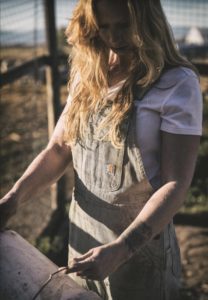

At Amaltheia Organic Dairy, Sarah Brown is the head cheesemaker, and oversees the day-to-day alongside her mother, Susan. PHOTO BY KENE SPERRY
Since the early 2000s, the Brown family has huddled at the base of the lush, sweet pastures of the Bridger Mountains, where they have teamed up at handcrafting organic goat cheeses.
What’s the secret to the family of four’s success as a cohesive unit and company?
“My parents feel that with the cheeses that they kind of control all aspects of it,” said Nathan Brown, owner and son of the family. “From milking to processing the milk into cheese, and then doing the sales for that. They are able to set the price they need to be able to make it, and a lot of dairies don’t get that option.”
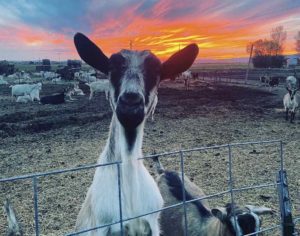

PHOTO BY KENE SPERRY
Sarah Brown is the head cheesemaker, and Sarah and her mother, Susan, oversee the day-to-day regimen of the cheese plant. Father Mel, whose lineage includes eight generations of farmers in England, serves as quality control inspector. Brother Nathan has worked on all of the disparate elements of the business, now primarily sticking to the business, engineering and composting sides of the operation.
The Browns are verifiable proof that every sliver of Earth has something untapped that can be done to make it more enriching. The name of the dairy is linked to Greek mythology, the she-goat nurse of the God Zeus who nourished him with milk in a cave.
“My mom was the one who came up with that, she was teaching a course on Greek mythology and came across Amaltheia,” said Nathan. “It has got a great story, but no one can pronounce it or spell it.”
From its inception Almatheia has manufactured cheese from goat milk that has been derived from its own flock of animals.
“We’ve always had the same kind of goats, Saanen, Alpines and American Lamanchas,” said Nathan. “Right now we’re just basically going to Saanens and Alpines. They’re really good goats for Montana. They gave a good amount of milk and we really have worked on our genetics and kind of fine-tuning really good markers.”
Alpine goats are fairly common milk goat breeds in the U.S., well suited for the often harsh environmental realities of Montana.
“They’ve got kind of an undercoat of cashmere,” said Nathan, “so they stay pretty warm as long as they have a shelter to get out of rain or snow.”
Specializes in Chèvre
Amaltheia specializes in chèvre—a tangy-tasting and aromatic cheese derived from goat’s milk. The company has received awards from the American Cheese Society for the exceptionally soft, buttery flavor of its chèvre line. The company’s ten chèvre cheeses include the olive medley, the perigord black truffle and the cranberry cinnamon.
“We do a lot of flavors of chèvre,” said Nathan. “That kind of has been our main cheese since the beginning. And it’s really a mild, delicious cheese that can be used in a variety of cooking applications.”
In addition to chèvre, the company has expanded its repertoire to include a few other diversely delectable fares.
“We do a really nice whole milk ricotta,” said Nathan. “Ricotta is really good in pasta and baking cheesecakes, things like that. We do feta cheese, which traditionally comes from sheep milk, but it’s really awesome. And my sister’s perfecting kind of an aged Alpine cheese … it’s really quite tasty.”
Amaltheia’s products could be found at a number of grocery stores and farm-to-table restaurants in the Gallatin and Paradise Valleys, including the Yellowstone Park Hotel, which serves up their golden yellow chèvre cheeses throughout the summer.
“We’ve had great partners in Montana that have helped us along the way,” said Nathan. “That all helps to showcase Montana agriculture and Montana food producers.”
In cheese, there is always something new to try and taste. As far as pairing suggestions, Nathan has several of them.
“The aged alpine Bozemano, it’s really good on a charcuterie board or a cheese and wine pairing,” Nathans explains. “Feta is a great salad cheese crumble and gives the salad a nice texture. We do a homemade ravioli with chèvre, plain or smoked or roasted garlic and chive. We roast and puree winter squash and mix with the chèvre cheese to make raviolis or pasta. My mom has a really good cheesecake recipe with the ricotta that makes it really rich and flavorful.”
Leaning on Clean Diet, Ag Practices
Supporting sustainable agriculture, such as raising animals in a more environmentally responsible and humane way, is a powerful draw for the Brown family. Positive ecological influences—fresh air, clean mountain water, an arrangement and routine mimicking the animals’ natural herding and grazing instincts—factor a great deal into the overall eminence of the cheese.
“We’re organic,” said Nathan, “so the goats are getting a pretty diverse diet. Good diet adds to the kind of complexity of the cheese. May through October, they’re grazing twice a day on a big 50-acre pasture, where we try to diversify the species of grasses and forbs that they’re eating … grains and legumes add a nice mineral mix to balance the goats. That’s all pretty important in the flavor of the cheese that we get.”
Lorelei Hallock, Hobby Dairyist, Livingston
South of Livingston, Lorelei Hallock maintains a herd of free roaming Nigerian Dwarf and American Saanen goats. Hallock, a fifth-generation Montana small-scale farmer, operates a small hobby dairy while preparing to launch a commercial cheesemaking outfit in the Paradise Valley in 2022.
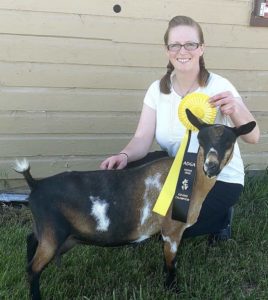

Lorelei Hallock is a hobby cheesemaker in Paradise Valley where she raises Nigerian Dwarf and Saanen goats. PHOTO COURTESY OF LORELEI HALLOCK
She grew up in the Bitterroot Valley and remembers the feeling of seeing her first goat herd at about age four. She loved trailing them around and her interest in them was remarkable and nearly instantaneous. A few years ago, she registered a few irascibly adorable Nigerian Dwarf goats as well as some big fluffy, white Saanen goats, and began experimenting with goat cheese.
“The two kinds of goats are on the opposite side of the spectrum,” said Hallock. “Saanens are kind of the Holsteins of the dairy goat world, your traditional, commercial dairy goats. They are docile and exist to love and be loved. They’re super common. They produce a huge amount of milk … Nigerians are a miniature breed of dairy goats. They’re only about 22 inches tall at the shoulders and produce a lot less milk.”
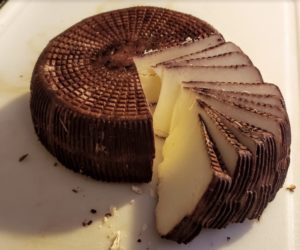

Hallock specializes in goat cheeses. Cheese from Nigerian Dwarf goats in particular is high in protein and butterfat, resulting in a sweeter taste. PHOTO COURTESY OF LORELEI HALLOCK
Nigerian Dwarf milk is notably higher in protein content and butterfat, which endows it with a purer, sweeter taste. And those wealthy components contribute to highly productive yields in its cheese production as well.
Exuberant Energy of Cheesemaking
One element of small batch cheesemaking that is often overlooked is the expenditure of effort—the commitment of time involved in the pursuit and perfection of high craftsmanship. Fresh, soft cheeses generally have a short production cycle, and consequently, they have shorter expiration dates or shelf periods than their counterparts. But products such as cheddars, or Colby varieties, or Goudas, the ones that Hallock opts to work with—handcrafted artisan cheeses—these take much more time to age.
“Hard cheeses like Colby, though shorter aging than others, still have to age for a minimum of six weeks,” explained Hallock. “Its shelf life is much longer, because it’s just going to get more sharp. Depending on what you’re doing for flavor, the longer you age something, like Parmesan, the better it is going to be. So, when it comes to the actual energy that we’re putting into cheese, artisan cheeses are going to be a lot more expensive since there’s so much more energy that goes into producing them.”
The price point of local, handcrafted cheese, while more expensive than the average bulk store-bought variety, might not seem so elevated when the customer weighs and considers the heavy sum of intensity and ambition mandated to bring such product to market.
“It’s important that the farmer is being fairly financially compensated for what it is that they’re producing,” said Hallock. “Many times with cheese, it’s a business entity that owns that farming operation and you’re not supporting a family, you’re supporting a corporate conglomerate. The reason that they are more expensive is because you’re paying the right person the right amount.”
Natural Flora of Montana Cheese
While still an adventurous culinary trip, cheese has rules, a basic recipe and standard formula, with the taste, flavor and profile of a particular cheese, shaped intensely by the lifestyle regimen of the animals. So much of the product is, she said, tied to “good animal husbandry,” which could be controlled, but there are other factors, like the weather, over which you have no control.
“I can take the exact same recipe and do everything as identical as possible to another cheesemaker,” said Hallock. “But it will be different since my goats have a different diet than what’s available to someone else. There will be different milk components, different flavors just due to the natural flora of Montana, and everything about our climate is going to lead to different things compared to the slightly warmer desert area that another cheesemaker is in.”
Indeed, finer cheesemaking is rooted in the elemental health and care of the animal. Unwell or unhealthy animals are not going to produce milk that results in exceptional taste or deliver finer, more nuanced components. If an animal lacks sound nutrition, then its shortcomings are going to be manifested in the milk and the cheese. This is why Hallock said that her goats have “lots of pasture to graze on,” and a diet punctuated with top-quality alfalfa and supplemented with high-fiber local grains and grain byproducts.
“In turn, all of that brings high-quality, rich flavors of milk,” said Hallock. “All of those natural factors are going to have an effect on the final product of our cheese.”




